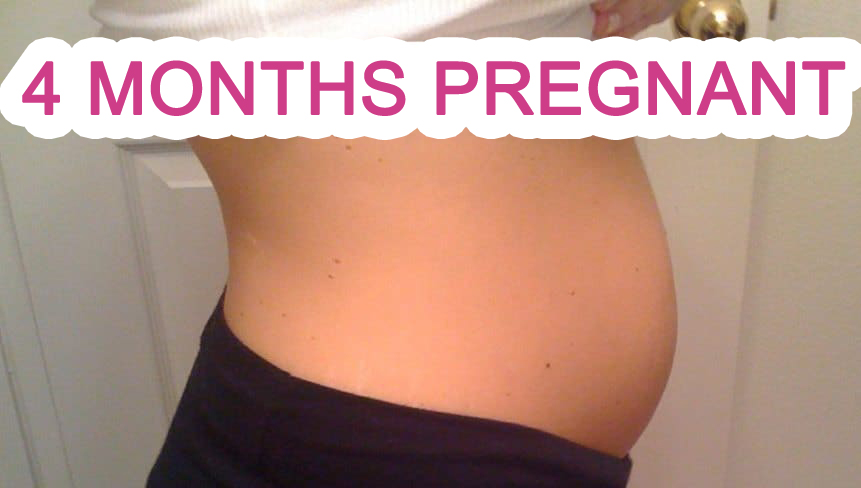Get ready to venture into the heart of your pregnancy journey – the second trimester. You’ve crossed the hurdle of the initial three months, and you’re now four months pregnant and beyond. Unveil what lies ahead as your sweet one grows inside you and your body transforms in unique ways you’ve never imagined. It’s a transformative journey, though sometimes challenging, but overall it’s rewarding knowing you’ll soon hold that little bundle of joy in your arms. So, buckle up for an amazing exploration of all things related to the golden period of pregnancy – welcome to the fantastic voyage of month four and onwards!
At 4 months pregnant, also known as the beginning of the second trimester, common symptoms may include reduced nausea, but digestive problems like heartburn and constipation might persist. Physical changes may include breast changes, shortness of breath, increased blood flow leading to bleeding gums, nosebleeds, or nasal stuffiness, and occasional dizziness due to changes in blood and blood vessels. As for fetal development, during this time, the fetus grows to about 3 inches (8 cm) in length and unique features start forming, like hair growth, prostate gland development in male fetuses, and ovaries moving down in female fetuses. It is important to consult with a healthcare professional for personalized guidance during this stage of pregnancy.
Table of Contents
What to Expect at 4 Months Pregnant
Congratulations! By the fourth month of pregnancy, you are entering the second trimester, and many of the early pregnancy symptoms have started to fade away. The fetus will be about three inches long and will weigh around one ounce. At this point, your belly may start showing your pregnancy. As fetal organs continue to develop, cord blood banking would be a wise option for consideration. You may also want to discuss with your doctor the best maternity ward or facility to deliver your baby if you haven’t already.
It’s important to remember that pregnancies differ from person to person, so symptoms and experiences may vary. However, it is generally a more comfortable period than the first trimester.
- The fourth month of pregnancy marks the beginning of the second trimester, with many early pregnancy symptoms starting to fade away. The fetus is about three inches long and weighs around one ounce. As fetal organs continue to develop, cord blood banking should be considered. Additionally, discussing with your doctor the best maternity ward or facility for delivery is important. Remember that every pregnancy is different, but generally, this period is more comfortable than the first trimester.
Doctor’s Appointment at 4 Months Pregnant
Your doctor’s appointment at four months pregnant is crucial in ensuring that both you and your baby are healthy. During this visit, the doctor will check on various aspects such as:
- Your weight
- Blood pressure
- Urine sample (to check protein levels)
- Height of the uterus or fundal height
- Fetal heartbeat via Doppler
- Any genetic testing or screening tests necessary
Depending on their findings, they will advise on any concerns or necessary precautions to take going forward.
Some women choose to do a gender reveal ultrasound at this point – which isn’t medically necessary but can provide additional excitement and bonding between parents and baby.
It’s crucial to discuss any concerns you might have with your medical provider freely. They are there to answer questions and give helpful advice throughout your pregnancy journey.
Understanding what body changes and symptoms occur during four months pregnant is essential. Let’s dig into this next!
Body Changes and Symptoms at 4 Months
Congratulations! You’ve made it to the second trimester, commonly referred to as the “honeymoon phase” of pregnancy. During this period, your body undergoes various changes in preparation for childbirth. At four months pregnant, you might start noticing some significant developments in both your baby and yourself.
In the following subsections, we’ll delve into the physical adjustments and common symptoms you’re likely to experience at this stage.
- According to the American College of Obstetricians and Gynecologists, at 4 months or between weeks 13-16, the fetus has a CRL (Crown-Rump Length) of about 3-4.5 inches (8-12 cm).
- A report from Planned Parenthood states that during this time frame, hundreds of thousands of eggs form in the ovaries of female fetuses, and hair begins to grow on all fetuses.
- The World Health Organization notes that common symptoms of pregnancy in the fourth month often include reduced nausea, digestive problems like heartburn and constipation, breast changes, shortness of breath, increased blood flow leading to potential for bleeding gums or nosebleeds, along with possible dizziness or faintness due to changes in blood and blood vessels.
Physical Adjustments
At four months pregnant, you’ll have gained around five pounds in weight and your uterus will now be approximately the size of a grapefruit. The expansion of your uterus results in a more noticeable baby bump; you might need to switch to maternity clothes soon if not already done so.
One significant adjustment that occurs during this time is hormonal fluctuations. You might feel like your emotions are all over the place, experiencing sudden mood swings or feeling emotional for seemingly no reason. Additionally, many women find their hair growing faster than usual during pregnancy while their nails become brittle and easily peel off; this could be attributed to hormonal increases as well.
Another prevalent adjustment involves the cardiovascular system. As your pregnancy progresses, your body pumps more blood in general and specifically to the uterus – a vital change for nurturing your developing baby. However, this increased blood flow can result in nosebleeds or nasal stuffiness.
For instance, Olivia had always suffered from regular nosebleeds since she was young but found it got worse when she got pregnant. “It felt like my nose was always clogged up. It was really frustrating,” Olivia describes.
However, an increase in blood flow isn’t necessarily bad news since it can help reduce shortness of breath and other respiratory problems.
It’s important to know that with every adjustment comes several symptoms that could prove challenging to manage.
Common Symptoms
By the time you hit your fourth month of pregnancy, you’ll likely be glad to be leaving some of the more unpleasant symptoms of the first trimester behind. However, it’s important to remember that every pregnancy is different, and while some women experience significant improvement in how they feel during this phase, others may continue to have morning sickness or other pesky symptoms. Some common symptoms that women typically experience in their 4th month of pregnancy can include:
- Lessening nausea, but digestive problems like heartburn and constipation may persist.
- Breast changes: Your breasts will continue to grow and become increasingly sensitive. Your nipples might darken, too.
- Increased blood flow leading to bleeding gums, nosebleeds, or nasal stuffiness
- Shortness of breath due to hormonal effects on lung function
- Dizziness or faintness due to changes in blood pressure and increased blood volume.
- Fatigue: While many women report increased energy levels during the second trimester, others may still feel tired due to growing baby demands.
Baby Development at 4 Months Pregnant
At 4 months pregnant, your developing fetus has grown significantly since the early weeks of embryonic development. They now weigh around four ounces – about the size of a pear – and are fully formed. Here are some key developments happening during this stage:
- Bones: Your baby’s bones are starting to harden and become denser.
- Hair: Hair begins to grow on your baby’s head.
- Sex organs: The biological sex of your fetus can sometimes be determined through an ultrasound at this stage. If you’re having a boy, his prostate gland is developing, and if you’re having a girl, her ovaries will move from her abdomen down into her pelvis.
- Mouth: The roof of your baby’s mouth forms in preparation for breastfeeding later on.
- Movement: By now, your baby is moving around and stretching their tiny limbs in the womb.
It’s important to note that while your baby is now fully formed, they still have a lot of growing to do over the coming months. By the end of this month, your baby will have more than doubled in weight!
With an understanding of baby development in the fourth month of pregnancy, let’s shift our focus to how you can care for yourself emotionally and mentally during this time.
Emotions, Mental Health, and Lifestyle Adjustments
The second trimester of pregnancy can be a time of emotional respite for some women. As the nausea and fatigue symptoms from the first trimester start to dissipate, women may feel more energized and less bogged down by the early stages of pregnancy. However, it’s common for this period to be marked by anxiety or worry about the health and well-being of the developing fetus, especially as ultrasounds and other medical testing become more frequent. It’s important to prioritize mental health during this period, seeking support from mental health professionals if necessary. Furthermore, it’s essential to claim personal time and space to engage in self-care activities that alleviate such anxiety.
For instance, taking breaks between work schedules or partaking in relaxing activities like meditation can help in reducing stress levels.
Lifestyle adjustments may also be necessary to ensure optimal physical and mental health. These can range from ensuring adequate rest to preparing the home environment for the baby’s arrival.
Nutrition and exercise recommendations form an essential aspect of these lifestyle adjustments.
Nutrition and Exercise Recommendations
Proper nutrition is essential at this stage of pregnancy since fetal development continues at an accelerated pace. Eating a balanced diet consisting of fruits and vegetables, whole grains, lean protein sources, and healthy fats can help ensure appropriate nourishment for both mother and baby. It’s also advisable to drink plenty of fluids – preferably water – throughout the day to stay hydrated.
Additionally, tracking daily caloric intake via meal log apps or consulting with healthcare professionals can provide useful insights into any nutrient deficiencies that need addressing; i.e., iron deficiency anemia.
Similarly, regular exercise can support optimal maternal health while reducing risks associated with complications like gestational diabetes or hypertension. According to guidelines put in place by The American College of Obstetricians and Gynecologists (ACOG) in 2018, pregnant women should aim for at least 150 minutes of moderate-intensity exercise per week to maintain overall health and well-being.
This could include activities like brisk walking, swimming, or prenatal yoga.
It’s crucial to consult with qualified obstetricians or gynecologists to determine a suitable exercise plan since each patient’s physical and medical condition may vary.

Elizabeth Baker is a mother of three, wife, and the passionate mind behind this pregnancy and baby development resource. She balances her love for understanding every stage of child growth with her duties as a parent. When she’s not sharing her experiences or studying child development, Sarah enjoys family time, reading, and practicing yoga. She believes in the power of shared knowledge to enhance the beautiful journey of parenthood. Read more About me.
